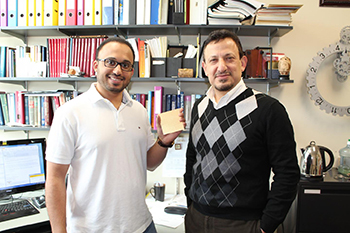
Thamer Almoneef (left) and Omar M. Ramahi, the University of Waterloo team behind the energy capturing metasurface. Credit: O.Ramahi/U.Waterloo
To meet the growing global demand for power, many researchers and engineers are looking to the sun as a potential source of abundant and clean energy. A group from the University of Waterloo, Canada, has developed a metamaterial based on the full-absorption concept that could transform nearly all the electromagnetic waves that touch its surface into electricity (App. Phys. Lett. A, doi: 10.1007/s00339-015-9081-8). Co-author Omar M. Ramahi says that the group’s metamaterial energy harvester “enables significantly higher energy absorption than classical antennas” as well as a smaller footprint.
Metamaterials are ideal for energy-harvesting systems because they can be designed to neither reflect nor transmit power—that is, for full absorption. The Waterloo team created a metamaterial design composed of a 13 x 13 array of electrically small cells. Each cell is loaded with an 82 Ω resonator that mimics the input impedance of a rectification circuit. Full absorption occurs when the metamaterial is tuned so that its impedance is matched to the free-space impedance (near-unity).
The other, crucial design component involved the actual harvesting of energy absorbed by the device. Rather than having the absorbed power dissipate through the dielectric substrate, as in earlier designs, the new material was fashioned with a conducting path (connecting the surface to a ground plane) to allow most of the power to be channeled across a resistive load. In a proof-of-concept experiment with the metamaterial design, using cells optimized for absorption at a microwave frequency of 3 GHz, the researchers found that 93 percent of the incident power was channeled to the resistive load.
The authors envision several applications for their metamaterial technology, including space solar power collection and wireless power transfer for remote devices. Next, the Waterloo researchers want to alter their metamaterial medium to allow near-unity energy absorption at infrared and visible wavelengths.
